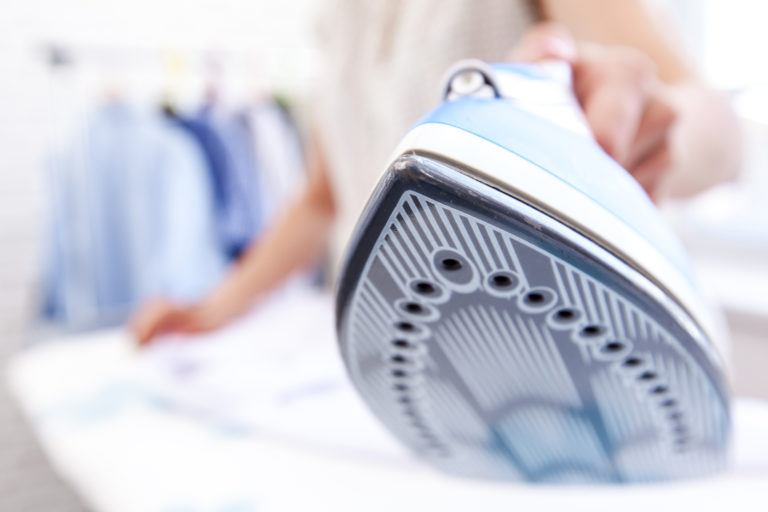
Quick Tips
- Gather your supplies.
- Know your iron.
- Start with the soleplate.
- Clean the steam vents.
- Rinse the reservoir.
- Clean the outside of your iron.
I am not someone who likes (or needs) to iron. At all. I am much more apt to take half an hour to stick the shirt in the dryer and pray that the wrinkles come out than to spend the five minutes it would take to just iron the thing. Because of this personality flaw, my iron is, of course, nasty dirty when I do need to unearth it, and then . . . ? I just go buy a new shirt.
But times are tough and money is tight now, and I realized I can’t keep buying new shirts willy-nilly. I figured I’d better learn how to clean an iron. The good news is that it’s not that hard. I admit when I started my investigation on how to clean irons, I figured that was the case: how hard can it be? But it was difficult at first because I tried many methods that didn’t quite do the job, or that required way more “elbow grease” than I was capable of using. But a couple of hours and a very messy kitchen later, I emerged with a shiny steam iron and a victorious smile. May the odds be ever in your favor when you clean your iron.
Steps to Cleaning an Iron
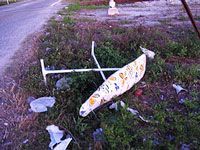 Gather your supplies. Once that steam iron starts catching or dragging or worse—when it gets your clothes dirty because it’s gross—you’ll know it’s time. Don’t give up and throw your ironing board in a ditch. You’ll be fine. In fact, you probably have what you need for a clean iron right at home. For the method that I found works best, get a couple of soft cloths, a scouring pad (for non-Teflon irons only), white vinegar, salt, distilled water, and some pipe cleaners (or Q-tips). Now you are ready to clean your iron.
Gather your supplies. Once that steam iron starts catching or dragging or worse—when it gets your clothes dirty because it’s gross—you’ll know it’s time. Don’t give up and throw your ironing board in a ditch. You’ll be fine. In fact, you probably have what you need for a clean iron right at home. For the method that I found works best, get a couple of soft cloths, a scouring pad (for non-Teflon irons only), white vinegar, salt, distilled water, and some pipe cleaners (or Q-tips). Now you are ready to clean your iron.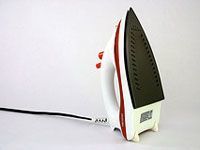 Know your iron. There are three main parts of any steam iron: the soleplate (the bottom), the steam vents (the holes on the bottom), and the reservoir (where the water goes). Those are the parts you will need to clean. It is also important to know whether or not your soleplate is coated with Teflon because if it is, you will need to clean it gently. The good news here is that it will be much easier to clean, just like Teflon-coated pots and pans. Also, know your On/Off switch. Better yet, unplug the iron before you begin. You know somebody out there learned that lesson the hard way.
Know your iron. There are three main parts of any steam iron: the soleplate (the bottom), the steam vents (the holes on the bottom), and the reservoir (where the water goes). Those are the parts you will need to clean. It is also important to know whether or not your soleplate is coated with Teflon because if it is, you will need to clean it gently. The good news here is that it will be much easier to clean, just like Teflon-coated pots and pans. Also, know your On/Off switch. Better yet, unplug the iron before you begin. You know somebody out there learned that lesson the hard way.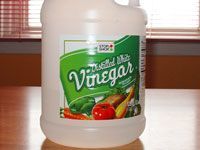 Start with the soleplate. A good rule when cleaning anything is to start with the mildest option first, which in this case (and certainly with Teflon irons) is dish soap. If this doesn’t do the trick—and it probably won’t for scorch stains on a steel plate—take equal parts white vinegar and salt and heat the mixture in a saucepan. Before it starts boiling, dip a clean cloth or scouring pad (the metal kind is not necessary and could scratch the plate) into the mixture and then scrub. Once the soleplate looks good as new again, use a fresh cloth to rinse with distilled water, and then dry. It’s a good idea to use rubber gloves, so you don’t burn yourself, and you may want to open a window. Vinegar can work magic, but it also stinks. *Note: Make sure you heat the mixture; cold vinegar and salt won’t do a whole lot for serious marks.
Start with the soleplate. A good rule when cleaning anything is to start with the mildest option first, which in this case (and certainly with Teflon irons) is dish soap. If this doesn’t do the trick—and it probably won’t for scorch stains on a steel plate—take equal parts white vinegar and salt and heat the mixture in a saucepan. Before it starts boiling, dip a clean cloth or scouring pad (the metal kind is not necessary and could scratch the plate) into the mixture and then scrub. Once the soleplate looks good as new again, use a fresh cloth to rinse with distilled water, and then dry. It’s a good idea to use rubber gloves, so you don’t burn yourself, and you may want to open a window. Vinegar can work magic, but it also stinks. *Note: Make sure you heat the mixture; cold vinegar and salt won’t do a whole lot for serious marks.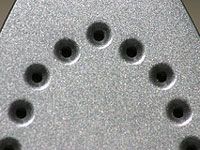 Clean the steam vents. Especially if you use hard water in the reservoir, the steam vents will get clogged with mineral deposits, and your iron won’t work as well. There are few different tools you can use to clean the vents, including Q-tips and paper clips, but pipe cleaners work best for me. Dip a pipe cleaner in some distilled water, and then insert it into each steam vent and twist until the hole is clear. If there is serious buildup in the vents, try the vinegar/salt mixture but be sure to rinse with distilled water afterward.
Clean the steam vents. Especially if you use hard water in the reservoir, the steam vents will get clogged with mineral deposits, and your iron won’t work as well. There are few different tools you can use to clean the vents, including Q-tips and paper clips, but pipe cleaners work best for me. Dip a pipe cleaner in some distilled water, and then insert it into each steam vent and twist until the hole is clear. If there is serious buildup in the vents, try the vinegar/salt mixture but be sure to rinse with distilled water afterward.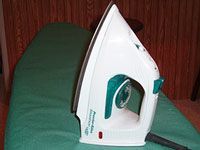 Rinse the reservoir. If you’ve found mineral deposits in your steam vents, they’re in the reservoir, too. Fill it ¼ to ½ the way with white vinegar, turn to the highest steam setting, and steam iron a clean cloth for 10–15 minutes—until the reservoir is empty. (At this point, check your mister to make sure it’s functioning properly. If it seems clogged, insert a straight pin in the hole.) Fill with clean, distilled water and repeat the process, and then recheck your steam vents in case any mineral deposits came through in the cleaning. *Note: Some people have found that using vinegar in the reservoir creates a brown sludge. This didn’t happen for me, but if it’s a problem for you, use only the distilled water.
Rinse the reservoir. If you’ve found mineral deposits in your steam vents, they’re in the reservoir, too. Fill it ¼ to ½ the way with white vinegar, turn to the highest steam setting, and steam iron a clean cloth for 10–15 minutes—until the reservoir is empty. (At this point, check your mister to make sure it’s functioning properly. If it seems clogged, insert a straight pin in the hole.) Fill with clean, distilled water and repeat the process, and then recheck your steam vents in case any mineral deposits came through in the cleaning. *Note: Some people have found that using vinegar in the reservoir creates a brown sludge. This didn’t happen for me, but if it’s a problem for you, use only the distilled water. Clean the outside of your iron. This is the easy part. Fun, even. Now that you’re finished with everything else, simply take a clean, wet cloth and wipe down the exterior of your steam iron. If there’s some crusty stuff, use a bit of dish soap and gently scrub the iron, and then use a clean cloth to dry it off. Make sure you’ve emptied all of the water from the reservoir, do a little dance, and you’ve got a clean iron!
Clean the outside of your iron. This is the easy part. Fun, even. Now that you’re finished with everything else, simply take a clean, wet cloth and wipe down the exterior of your steam iron. If there’s some crusty stuff, use a bit of dish soap and gently scrub the iron, and then use a clean cloth to dry it off. Make sure you’ve emptied all of the water from the reservoir, do a little dance, and you’ve got a clean iron!
How to Care for Your Iron
The single most important thing you can do to keep your iron as clean as possible is to take care of it. When your iron is on, make sure it takes center stage; you don’t want any kind of material to somehow “fall” onto it (like Tupperware or a brick of cheese), so keep it away from stuff like that. If you’re able to use distilled water in the reservoir when you steam iron, do so, as you’ll have a lot less mineral deposits collecting in the reservoir and clogging the steam vents. These deposits also collect if there is any water left after an ironing session, so be sure to empty the reservoir after each use. It is also a good idea to wipe the exterior of your iron every time you use it to avoid the transfer of dirt, etc., to the ironing board and thus to your nice, clean clothes. Finally, store your iron in the upright position in a clean and dry place, and let it bask in its cleanness until whenever it is you decide that you just have to iron again.
Alternate Ways to Clean an Iron
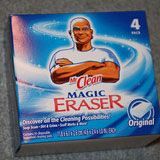 Magic Erasers have stolen the hearts of many ironers; it’s amazing how many people swear by them for really tough stains. I haven’t tried one to clean my own iron, but it seems easy—just wet a corner of the eraser and scrub your soleplate. Because the eraser is abrasive, however, I would test a small area of the plate first just in case , and I wouldn’t use it with Teflon. But if you want to give it a try, you can order a 10 pack of Magic Erasers from Amazon.
Magic Erasers have stolen the hearts of many ironers; it’s amazing how many people swear by them for really tough stains. I haven’t tried one to clean my own iron, but it seems easy—just wet a corner of the eraser and scrub your soleplate. Because the eraser is abrasive, however, I would test a small area of the plate first just in case , and I wouldn’t use it with Teflon. But if you want to give it a try, you can order a 10 pack of Magic Erasers from Amazon.
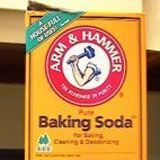 Baking Soda is a natural way to clean irons, though avoid using the paste (1–2 Tbsp baking soda and a little water) on Teflon-coated soleplates. A word of caution: when I tried this, my steam vents became way more clogged than they were before. Pipe cleaners took care of it, but the extra step was kind of a hassle.
Baking Soda is a natural way to clean irons, though avoid using the paste (1–2 Tbsp baking soda and a little water) on Teflon-coated soleplates. A word of caution: when I tried this, my steam vents became way more clogged than they were before. Pipe cleaners took care of it, but the extra step was kind of a hassle.
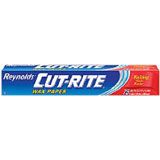 Waxed paper can help loosen tough stains, especially if you add a little salt to the paper and then iron on a high setting. Many people have found that the waxed paper can also keep the iron sliding smoothly/ Try running your iron on a piece of it after you’ve cleaned the soleplate.
Waxed paper can help loosen tough stains, especially if you add a little salt to the paper and then iron on a high setting. Many people have found that the waxed paper can also keep the iron sliding smoothly/ Try running your iron on a piece of it after you’ve cleaned the soleplate.